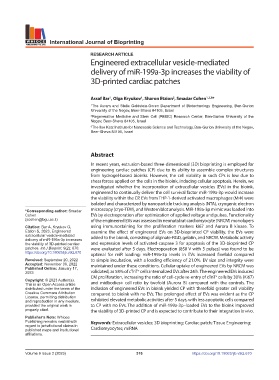Page 324 - IJB-9-2
P. 324
International Journal of Bioprinting
RESEARCH ARTICLE
RESEARCH ARTICLE
Engineered extracellular vesicle-mediated
delivery of miR-199a-3p increases the viability of
3D-printed cardiac patches
Assaf Bar , Olga Kryukov , Sharon Etzion , Smadar Cohen 1,2,3 *
2
1
1
1 The Avram and Stella Goldstein-Goren Department of Biotechnology Engineering, Ben-Gurion
University of the Negev, Beer-Sheva 84105, Israel
2 Regenerative Medicine and Stem Cell (RMSC) Research Center, Ben-Gurion University of the
Negev, Beer-Sheva 84105, Israel
3
The Ilse Katz Institute for Nanoscale Science and Technology, Ben-Gurion University of the Negev,
Beer-Sheva 84105, Israel
Abstract
In recent years, extrusion-based three-dimensional (3D) bioprinting is employed for
engineering cardiac patches (CP) due to its ability to assemble complex structures
from hydrogel-based bioinks. However, the cell viability in such CPs is low due to
shear forces applied on the cells in the bioink, inducing cellular apoptosis. Herein, we
investigated whether the incorporation of extracellular vesicles (EVs) in the bioink,
engineered to continually deliver the cell survival factor miR-199a-3p would increase
the viability within the CP. EVs from THP-1-derived activated macrophages (MΦ) were
isolated and characterized by nanoparticle tracking analysis (NTA), cryogenic electron
*Corresponding author: Smadar microscopy (cryo-TEM), and Western blot analysis. MiR-199a-3p mimic was loaded into
Cohen EVs by electroporation after optimization of applied voltage and pulses. Functionality
(scohen@bgu.ac.il) of the engineered EVs was assessed in neonatal rat cardiomyocyte (NRCM) monolayers
Citation: Bar A, Kryukov O, using immunostaining for the proliferation markers ki67 and Aurora B kinase. To
Etzion S, 2023, Engineered examine the effect of engineered EVs on 3D-bioprinted CP viability, the EVs were
extracellular vesicle-mediated added to the bioink, consisting of alginate-RGD, gelatin, and NRCM. Metabolic activity
delivery of miR-199a-3p increases
the viability of 3D-printed cardiac and expression levels of activated-caspase 3 for apoptosis of the 3D-bioprinted CP
patches. Int J Bioprint. 9(2): 670. were evaluated after 5 days. Electroporation (850 V with 5 pulses) was found to be
https://doi.org/10.18063/ijb.v9i2.670
optimal for miR loading; miR-199a-3p levels in EVs increased fivefold compared
Received: September 20, 2022 to simple incubation, with a loading efficiency of 21.0%. EV size and integrity were
Accepted: November 08, 2022 maintained under these conditions. Cellular uptake of engineered EVs by NRCM was
Published Online: January 17,
+
2023 validated, as 58% of cTnT cells internalized EVs after 24 h. The engineered EVs induced
+
CM proliferation, increasing the ratio of cell-cycle re-entry of cTnT cells by 30% (Ki67)
Copyright: © 2023 Author(s).
This is an Open Access article and midbodies+ cell ratio by twofold (Aurora B) compared with the controls. The
distributed under the terms of the inclusion of engineered EVs in bioink yielded CP with threefold greater cell viability
Creative Commons Attribution compared to bioink with no EVs. The prolonged effect of EVs was evident as the CP
License, permitting distribution
and reproduction in any medium, exhibited elevated metabolic activities after 5 days, with less apoptotic cells compared
provided the original work is to CP with no EVs. The addition of miR-199a-3p–loaded EVs to the bioink improved
properly cited. the viability of 3D-printed CP and is expected to contribute to their integration in vivo.
Publisher’s Note: Whioce
Publishing remains neutral with Keywords: Extracellular vesicles; 3D bioprinting; Cardiac patch; Tissue Engineering;
regard to jurisdictional claims in
published maps and institutional Cardiomyocytes; miRNA
affiliations.
Volume 9 Issue 2 (2023) 316 https://doi.org/10.18063/ijb.v9i2.670

